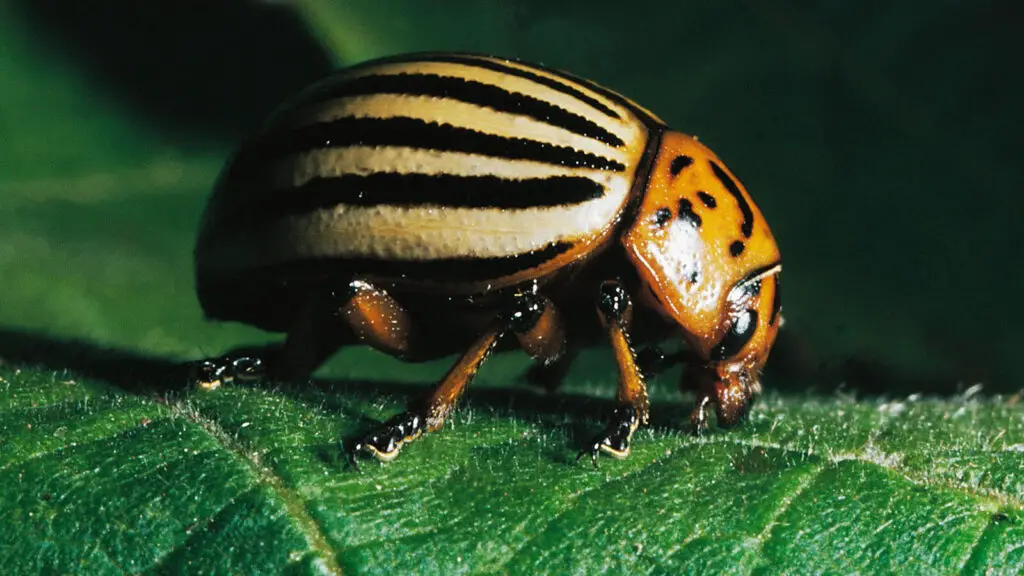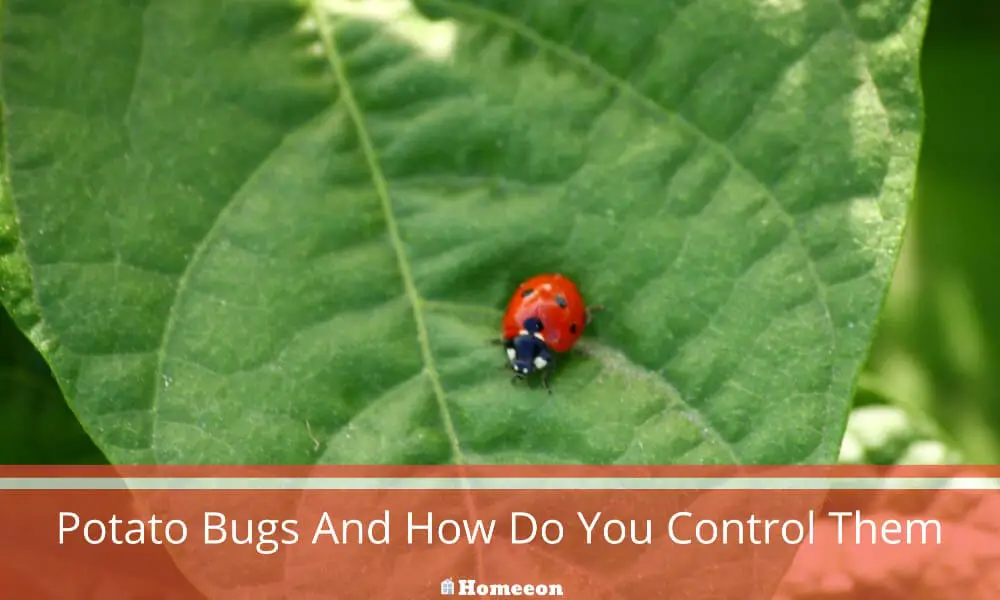Last Updated on August 15, 2023 By Emma W. Thomas
Potato bugs, or Colorado potato beetles, are harmful pests that devour potato plants. Control by handpicking, using neem oil or insecticidal soap, or introducing natural predators like ladybugs. Early intervention and rotating crops help reduce their impact effectively.
What Are Potato Bugs?
Potato bugs, also known as Colorado potato beetles (Leptinotarsa decemlineata), are destructive insects that belong to the family Chrysomelidae. These pests are a significant concern for potato farmers and gardeners, as they feed voraciously on potato plants and related crops, such as tomatoes and eggplants.
Physical Characteristics: Adult Colorado potato beetles are approximately 3/8 to 1/2 inch (10-12 mm) long, with distinctive yellow-orange bodies featuring ten black stripes on their wing covers. The larvae, commonly referred to as potato bug larvae, are reddish-orange and about 1/4 inch (6 mm) long when newly hatched. As they mature, they grow to around 1/2 inch (12 mm) and develop a more characteristic appearance with a humped back and spines.
Lifecycle and Behavior: Colorado potato beetles undergo complete metamorphosis, consisting of four life stages: egg, larva, pupa, and adult. Adult beetles emerge in the spring and lay clusters of bright yellow-orange eggs on the underside of leaves. Larvae hatch from these eggs and start feeding on the foliage. They undergo several molts before pupating in the soil. The adults emerge from pupation and continue to feed and reproduce throughout the summer.
Damage: Both larvae and adult Colorado potato beetles cause damage to plants by voraciously consuming leaves. This feeding can significantly weaken the plant, reducing its ability to produce potatoes or other crops. Severe infestations can result in defoliation, yield loss, and reduced crop quality.
Where They Are Found

Jerusalem crickets are mostly found in the Western and South Western USA. They are also found in some parts of Mexico but never in Jerusalem, as their name would suggest. This bug is a nocturnal creature that lives below the surface of your soil. The pest measures about 2.5 inches and looks strange with a large head for its body.
The insects dig into the ground using their thick limbs. Their legs are yellow and red while the midsections have brown and black stripes.
Colorado potato beetles are found in different parts of the world, such as Alaska, the Mainland USA, Europe, Hawaii, and Asia. These insects are found in all states, and they are significant pests for both commercial agriculture and home gardeners.
The Colorado potato beetle measures roughly 3/8 inches and has the round shape of a beetle. They are orange in color with white and black stripes. These insects can fly and pose an infestation risk if they appear in swimming.
Are Potato Bugs Bad?
Potato bugs eat the stems and leaves of a potato plant, and if they are many, they can completely defoliate your plants. Potato plants can tolerate infestations in the early season, but if the problem occurs when tubers are growing actively, it becomes severe.
Jerusalem crickets become a threat when in swarms and can be removed using various methods if they are few. You can remove woodpiles and old pots from your fields that act as hiding spots. Beetles require more effort to eliminate as they hatch in large numbers and cause more damage.
Are Potato Bugs Harmful To Humans?
Both Colorado beetles and Jerusalem crickets are not hazardous to human beings. Jerusalem crickets can, however, bite and cause pain. Avoid provoking the pests directly but instead, allow them to fly.
Beetles are entirely harmless to humans, and their threat is only to your plants.
How To Protect Your Crops From Potato Bugs
Colorado potato beetles are the greatest threat to your crops since each female can lay up to 25 eggs at once. Once the eggs hatch, the larvae feed on your plants and eventually destroy them. Preventing a potato bug infestation is more comfortable than getting rid of them once they invade.
Try these methods to eliminate beetles from your field;
1. Crop Rotation
Do not plant your potatoes in the same spot every year, as doing this will give beetles access to your plants. The creatures will conveniently find a mate, pick a plant, lay eggs, and continue with this cycle.
2. Companion Planting
Some plants can deter beetles if you plant them alongside or interplant with your potatoes. These plants include sage, tansy, and catnip but be careful when growing since tansy and catnip can spread quickly.
Be sure to put them under control by uprooting any unwanted young plants or not allowing them to seed.
3. Early-Maturing Or Resistant Plant Varieties
You can plant potato varieties that are resistant to Colorado beetles such as Russet Burbank. Planting varieties that mature early could also be helpful since damage by beetles only worsens as the season progresses and the eggs hatch. Yukon Gold, Norland, and Caribe potatoes are all early-maturing varieties planted for the early season.
4. Floating Row Covers
You can place floating row covers on top of your plants and allow them to sit. This unique material lets in air and light but keeps away hungry potato beetles.
5. Straw Mulching
You can also mulch your potatoes heavily with straw to keep the tubers out of sunlight. Mulching will also help create a suitable habitat for ground beetles, green lacewings, and ladybugs, which feed on the Colorado potato beetles.
6. Rear Ducks, Geese, Chickens, Or Guineas
When your plants are relatively mature, allow your poultry to wander through the farm from time to time. They will pick off potato bugs and help keep them under control.
7. Organic Treatments
You can apply various methods to put potato beetles under control once they infest your plants. You will need to act fast and combat these annoying creatures immediately after you spot them. Here are some of these methods;
1. Hand-pick the beetles, eggs, and larvae and place them in a bucket containing soapy water to kill them
2. Apply neem oil, which is an organic gardener’s go-to insecticide. This product works better than most conventional options
3. Use a special bug vacuum to remove the eggs, larvae, and beetles. You can also use an ordinary handheld household vacuum to get rid of the creatures
Why You Find Potato Bugs In Your House

The presence of potato bugs in your house is an indication of an outdoor infestation. When the pests population increases, they may move inside your home to look for alternative shelter and food. If your yard has excessive debris and moisture, it could harbor pill bugs.
Heavy rainfall could also drive the pests inside during early summer and in the spring.
Final Word
Potato bugs can be a menace to your plants if allowed to infest your gardens in large numbers. These crawling pests are named potato bugs due to their eating habits as they feed on the leaves, tubers, and even your plants’ roots.
If you don’t get rid of these creatures, they can destroy your potatoes and other crops such as peppers, eggplants, and tomatoes. You can prevent the pest by using chemical insecticides, baiting, trapping, or physically removing them from the plants.
References:
https://www.solutionsstores.com/how-to-get-rid-of-potato-bugs-in-your-garden
https://www.planetnatural.com/pest-problem-solver/garden-pests/colorado-potato-beetle-control/
Emma is a graduate of Domestic Science or Family and Consumer Sciences (Home Economics) from the University of Wisconsin. She has 7 years of experience Working with the strategic section of BestBuy and now writing full-time for Homeeon.
From Managing the Home, Interiors, Cleaning, and Exteriors to Gardening and everything about Making A Home Liveable – is her passion and this Homeeon is the result of this.
Emma loves decorating her home with the best stuff found online. She cares about quality over anything and writes reviews about them here in Homeeon. Get in touch with her over Pinterest.
Keep reading her blogs.

